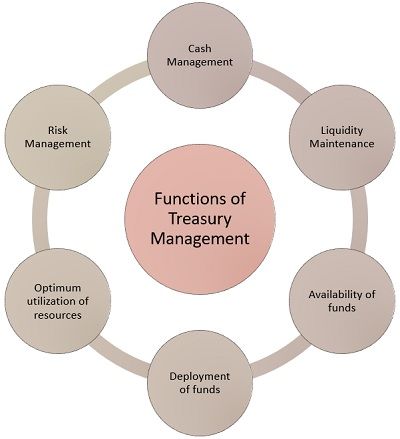Definition: Treasury Management can be understood as the planning, organizing and controlling holding, funds and working capital of the enterprise in order to make the best possible use of the funds, maintain firm’s liquidity, reduce the overall cost of funds, and mitigate operational and financial risk.
It covers working capital management, currency management, corporate finance and financial risk management.
Simply put, treasury management is the management of all financial affairs of the business such as raising funds for the business from various sources, currency management, cash flows and various strategies and procedures of corporate finance.
Functions of Treasury Management
Treasury Management aims to ensure that adequate cash is available with the organisation, during the outflow of funds. Further, it also contributes to optimum utilization of funds and makes sure that there are no unutilized funds kept in the firm for a very long term. The functions of treasury management are discussed below:
- Cash Management: Treasury Management includes cash management, and so it ensures that there are an effective collection and payment system in the organization.
- Liquidity Management: An optimum level of liquidity should be maintained in the business, for the better and smooth functioning of the business, i.e. the company must be able to fulfil its financial obligation when they become due for payment, such as payment to suppliers, employees, creditors, etc.And to do so, cash flow analysis and working capital management act as the most important tool for treasury management, to achieve its strategic goals.
- Availability of funds in adequate quantity and at the right time: The treasury manager has to ensure that the funds are available with the organization in sufficient quantity, i.e. neither be more nor less, to fulfil the day to day cash requirement for the smooth functioning of the enterprise.Further, timely availability of funds also smoothens the firm’s operations, resulting in the certainty as to the amount of inflows available with the company at a particular point in time.
- Deployment of funds in adequate quantity and at the right time: The deployment of funds has to be done in right quantity such as the acquisition of fixed assets, purchase of raw material, payment of expenses like rent, salary, bills, interest and so forth. For this purpose, the treasury manager has to keep an eye on all receipts of funds and the application thereof.Further, the funds must be available at the time of need, which may be different for different firms and also for the purpose for which they are used. The period may differ from a week to month when it comes to acquisition of the fixed assets and two to three days in case of working capital requirement.
- Optimum utilization of resources: Treasury Management also aims at ensuring the effective utilization of the firm’s resources, to reduce the operating costs and also prevent liquidity shortage in the coming time.
- Risk Management: One of the primary objectives of the treasury management is to manage financial risk to allow the enterprise to meet its financial obligations, as they fall due and also ensure predictable performance of the business. It tends to identify, measure, analyse and manage risk in order to mitigate losses, that has the potential to affect the company’s profitability and growth in any way.Hence, treasury management is accountable for all types of risk that can influence the business entity.
Further, the treasury management intends to maximise return on the funds available with the company, by making such investments which have higher return and low risk.


indika silva says
very good explanation & ease to remote studies .
Kailash Ahire says
Very nice explanation and easy to understand.
Ajay Ojha says
Thanks for the valuable information.